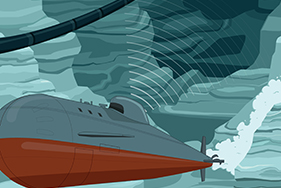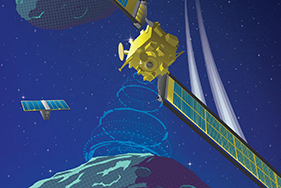Defining Innovations
Among APL’s thousands of critical contributions to national security and space exploration are a number of defining innovations: game-changing breakthroughs in technology that have created inflection points in history. These revolutionary advances have ignited new engineering accomplishments globally, saved lives, and secured the United States against threats at home and abroad.
APL developed the Defining Innovations poster series to celebrate these breakthroughs. Learn more about our Defining Innovations below and download a digital poster. Links will open in a new window.
Our Defining Innovations

Radio Proximity Fuze: APL’s First Game-Changing Technology
Less than six months after the Japanese attack on Pearl Harbor, APL was established to perfect and field one of America’s most closely guarded wartime secrets—the radio proximity fuze. Called the VT fuze to protect its true capability, the device was a complex system of miniaturized electronics packed into the tip of anti-aircraft shells that were rugged enough to survive the 20,000 g force of being fired from a naval gun and sensitive enough to detonate a shell in close proximity to fast-moving enemy aircraft. When it was fielded, the radio proximity fuze reduced the number of anti-aircraft shells required to down an enemy aircraft from an average of 2,400 to just a few. More than 23 million fuzes were produced for U.S. and Allied forces during the war, dramatically increasing the effectiveness of air defenses in the Pacific and playing a vital role in the Battle of the Bulge in Europe. The radio proximity fuze has been judged by historians as one of the three most important developments of the war—along with radar and the atomic bomb.

APL: The Birthplace of U.S. Navy Surface-to-Air Missiles
In 1944, APL set out to develop a guided missile that could strike enemy aircraft at a distance of 10–20 nautical miles. By the next year, they had conducted the first successful supersonic ramjet engine flight test and, with continuous advances in aerodynamics and missile guidance control technology, APL gave birth to the Navy’s first generation of surface-to-air guided missiles—Talos, Terrier, and Tartar. Further advances in partnership with industry resulted in the Navy’s first operational shipboard missile defense system, the Terrier II, in the early 1950s. The need for smaller missiles aboard ship led the Navy to adopt an APL design that reduced the size of dorsal fins and relied primarily on tail-fin steering control—a design that evolved into the modern variants of the Standard Missile. Today, APL remains the technical direction agent for the Navy’s Standard Missile program, including the SM-2 and SM-6, which are the backbone of Navy air defenses, and the SM-3, a critical component of the nation’s sea-based ballistic missile defense.

Transit: The World’s First Satellite-Based Global Navigation System
In the days after the launch of the Soviet Union’s Sputnik satellite in 1957, scientists around the world tried unsuccessfully to determine the satellite’s orbit using a variety of methods. Two young APL physicists carefully observed and recorded the Doppler shift in signals transmitted by Sputnik and were soon able to accurately determine its orbit in a single overhead pass. Others at APL realized that if the satellite’s orbit was known, the inverse equation could pinpoint locations anywhere on Earth’s surface within the satellite’s coverage. With funding from the Defense Advanced Research Projects Agency (DARPA) and the U.S. Navy, APL created the world’s first global satellite navigation system, comprising a constellation of 36 satellites that provided worldwide navigation for the Navy’s ballistic missile submarine force. Subsequent technology advances led to the ultra-stable oscillators needed to maintain precise frequencies and timing and dual-frequency processing, which are essential to modern navigation and telecommunications. Transit was the most significant advance in navigation since the shipboard chronometer and served a wide range of military and commercial needs until the early 2000s.

AMFAR: Pathway to Phased Array Radar
By the late 1950s, it was clear that existing radar technology was unable to detect, track, and guide U.S. surface-to-air missiles against multiple attacking enemy aircraft or missiles. To address this critical challenge, APL developed a “phased array” radar system for the Navy. The system was designed to provide the near-instantaneous scanning, tracking, and closed-loop guidance needed to defend against simultaneous aircraft and missile raids. Advances led to a prototype phase shifter—a key element of a phased array—along with the radar-beam control algorithms and software and the complex signal processing needed to discriminate real targets from environmental clutter and signal noise. By 1969, APL had built and tested a prototype phased array radar system known as AMFAR (advanced multi-function array radar). This system was the precursor to the AN/SPY-1A, a key enabler of the Navy’s Aegis Combat System. Today, the legacy of APL’s AMFAR lives on in the AN/SPY-1 radar and its successors, which provide the continuous radar coverage needed to defend the U.S. Navy, as well as the navies of Japan, Australia, Spain, and South Korea, against multiple, simultaneous aircraft and missile attacks.

Exploiting Undersea Physics: Enabling Advanced Sonar Arrays
When experiments with long-line towed sonar arrays in the 1980s failed to detect threat submarines at longer ranges as expected, APL developed the tests, prototypes, models, and detailed ocean physics and engineering analyses needed to unlock the potential of this revolutionary technology application. APL led developments and prototyping efforts, including the SURTASS 3X array (almost three miles long), that profoundly improved our ability to detect advanced threat submarines at significantly increased ranges. APL’s groundbreaking undersea research and development provided the foundation for the powerful long-range towed arrays in use throughout the U.S. Navy today aboard submarines, surface combatants, and surveillance platforms, and guided the stealth design requirements for multiple generations of U.S. submarines.

SATRACK: Transforming Ballistic Missile Testing
As part of our nation’s sea-based nuclear deterrence strategy, the U.S. Navy launched an initiative in the 1970s to improve the accuracy of its submarine-launched ballistic missiles. To meet this critical challenge, APL developed SATRACK, a missile-borne instrumentation package that collects raw GPS data that is combined with missile telemetry and detailed error-estimation models to predict missile accuracy and also predict missile trajectories that cannot be flown, anywhere in the world. APL’s technology and methodology were quickly adopted by the Navy, cutting in half the number of flight tests required to precisely estimate weapon system accuracy and thus saving billions of dollars in flight-test costs. More significantly, APL’s developments enabled the Navy to successfully deploy Trident II and achieve an unparalleled level of accuracy that today ensures the U.S. Strategic Command is able to fulfill its mission.

Tomahawk: The World’s First Long-Range, Autonomous, Precision-Guided Weapon
In the early 1970s, the Navy sought APL’s help to field a long-range nuclear cruise missile that could navigate heavily defended environments and strike strategic targets. Such a weapon required a means to verify and adjust its location en route to a target. To solve this problem, APL engineers applied terrain contour matching (TERCOM) technology, which matches the missile’s onboard altimeter readings to elevation maps stored in its computer. APL developed algorithms to reliably predict what ground areas would provide correct matches. When greater accuracy was needed for conventionally armed Tomahawks, APL developed the performance prediction algorithms needed to apply digital scene matching area correlator (DSMAC) technology, which further increased accuracy by comparing images taken by an onboard camera to scenes stored in the missile computer. The conventional land-attack Tomahawk enabled by TERCOM and DSMAC became the world’s first long-range, autonomous, precision-guided weapon, and it has been a key element of the U.S. arsenal since the early 1990s. TERCOM and DSMAC remain operational on Tomahawk for use when GPS is not available.

Cooperative Engagement Capability: Networking Fleet Air Defenses
Faced with the threat of highly advanced air and missile attacks against its battle groups in the 1980s, the U.S. Navy called on APL to develop a real-time sensor networking concept called the Cooperative Engagement Capability (CEC), which would combine and integrate radar measurements of multiple ships into composite tracks that would be more accurate and persistent than tracks generated by individual ship radars. The system provided ships in a battle group with an identical radar picture of threats in intense hostile electronic jamming environments, allowing ships to fire and guide surface-to-air missiles against targets using data from the radar systems of other ships or aircraft, even when the firing ship’s own radar could not detect or track the targets. Today CEC is installed in more than 120 U.S. Navy ships and airborne early warning aircraft and provides the foundation for the next-generation Naval Integrated Fire Control – Counter Air (NIFC-CA) capability, which allows Navy ships and aircraft to engage threats well beyond the horizon.

Discovery: Pioneering Low-Cost Planetary Exploration
The high cost of the space shuttle program in the late 1970s and 1980s significantly reduced funding for NASA’s planetary science missions, which at the time typically cost more than $1 billion each. Convinced that it could design, build, and operate missions well below that threshold, APL proposed a generation of ambitious, low-cost planetary missions. In its first opportunity to prove the viability of its low-cost approach, APL developed the Near Earth Asteroid Rendezvous (NEAR) mission, the first to orbit an asteroid. APL designed and developed the spacecraft more rapidly and less expensively than had ever been attempted for a planetary science mission; it was a stunning success. After a year of orbiting the asteroid Eros, APL engineers softly landed the spacecraft on the asteroid—where it continued to transmit science data back to Earth for two weeks. The success of the NEAR mission established APL as a national leader in low-cost planetary exploration and inspired the creation of NASA’s Discovery and New Frontiers programs, paving the way for the profound scientific discoveries resulting from APL’s MESSENGER Mercury orbiter, launched in 2004, and New Horizons, which launched in 2006 and completed its historic flyby of Pluto in 2015.

Ballistic Missile Defense From the Sea
APL responded to the critical challenge of proliferating ballistic missile threats, leading the development of the transformational system needed to demonstrate Ballistic Missile Defense (BMD) from the sea. The resulting experiments proved that BMD technology could be integrated with a Navy weapon system to “hit a bullet with a bullet” in space from the sea. APL’s critical contributions opened the door for the Navy’s central role in BMD. The resulting impact is felt far beyond our nation’s shores as BMD now provides enduring defense at sea and ashore across the globe.

Planetary Defense
For more than a decade, APL engineers and scientists developed game-changing concepts and technologies to prove that it was possible to defend our planet from an asteroid on a potentially catastrophic Earth-impact trajectory. APL established the technological basis for planetary defense; solidified the domain as a research and development area at the federal level; played key roles in defining and exercising interagency and international coordination responsibilities; and captured worldwide attention by successfully completing the DART mission, the first in-space demonstration of planetary defense technology.